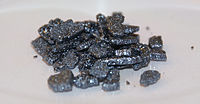
Photo from wikipedia
Abstract The nitrosyl complexes trans(L,L)-[RuNO(L)2Cl3] (L = indazole (I) and imidazole (II)) were synthesized and comprehensively characterized including by single crystal X-ray diffraction. Both compounds exhibit light-induced NO release under… Click to show full abstract
Abstract The nitrosyl complexes trans(L,L)-[RuNO(L)2Cl3] (L = indazole (I) and imidazole (II)) were synthesized and comprehensively characterized including by single crystal X-ray diffraction. Both compounds exhibit light-induced NO release under blue or green light (445, 532 nm) irradiation of DMSO solutions, complex (I) also shows NO release under red 638 nm irradiation, which is in the range of phototherapeutic window (600-1100 nm). The photolysis was investigated by spectroscopic (UV-vis, IR, EPR) and electrochemical (CV) techniques, and it was shown that NO can be activated by both light excitation or electrochemically. Performed DFT calculations allow to reveal possible charge transfers responsible for the NO activation. The dynamics of ruthenium species after irradiation consists of a transformation of [Ru3+(DMSO)(L)2Cl3] complex to a more stable [Ru2+(DMSO)(L)2Cl3]- product. The cytotoxic test of both complexes against breast adenocarcinoma cell line MCF-7 shows, imidazole complex (II) exhibits cytostatic action at concentrations higher than 25 µM, while indazole complex (I) is highly cytotoxic with IC50 value of 3.1 ± 0.6 µM, which is an order of magnitude higher than the activity of cisplatin. New knowledge open the prospects for the design and synthesis of prominent compounds trans(L,L)-[RuNO(L)2Cl3], where the nature of L influences the photo-sensitive and cytotoxic properties of the resulted complexes.
Journal Title: Journal of Photochemistry and Photobiology A: Chemistry
Year Published: 2021
Link to full text (if available)
Share on Social Media: Sign Up to like & get
recommendations!